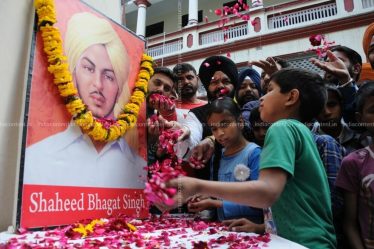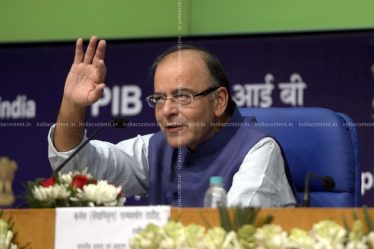
On September 28, 1907, a boy was born in the Lyallpur district of the Punjab Province of British India. This boy created an unreplaceable space in India’s struggle for freedom and in the hearts of Indians. The nation is remembering freedom fighter Shaheed Bhagat Singh on his 112th birth anniversary today.
Bhagat Singh—A revolutionary freedom fighter
Bhagat Singh was one of India’s most influential revolutionaries and is often referred to as Shaheed Bhagat Singh. History claims that Bhagat Singh was feared as a “gun-toting nationalist” by the colonizers. In fact, Bhagat Singh wanted a soldier’s death and requested the British authorities that he and his associates, Sukhdev and Rajguru, either be blown by a cannon or be shot dead instead of being hanged like criminals. But, unfortunately, his request was rejected. He even wrote to the Punjab Governor just before his execution that he and his associates had fought like soldiers to free their country from the British Colonial rule, so they should be granted the honor of dying like soldiers. However, the Punjab government did not pay any heed to his request. Britishers not only hanged him before dawn, ahead of the scheduled time on March 23 but also kept his body on the noose for about an hour. They did this as they were scared that the unconquerable spirit of the martyr will spring back to life.
Shaheed Bhagat Singh sacrificed his life for India’s freedom at the age of 23. He not only struggled for the independence of the nation but also had a vision for free India.
Bhagat Singh’s Early Life
Bhagat Singh was very young when he started following the Non-Cooperation Movement which was initiated by Mahatma Gandhi. Bhagat Singh openly opposed the British and followed Gandhi’s wishes by burning the government-sponsored books. He even left the school to enroll at the National College in Lahore. When Singh was a teenager, two incidents happened in his life which shaped his strong patriotic outlook – the Jallianwala Bagh Massacre in 1919 and killing of unarmed Akali protesters at the Nankana Sahib in 1921. The India Content website has images of the grandson of Shaheed Bhagat Singh in which he carries the soil of Jallianwala Bagh Punjab at India Gate, New Delhi.

His family believed in the Gandhian ideology of non-violent approach to attain Swaraj and for a while, Bhagat Singh also supported the Indian National Congress and the causes behind the Non-Cooperation Movement. Following the Chauri Chaura Incident, Gandhi called for the withdrawal of the Non-Cooperation Movement. But, Bhagat Singh was not happy with the decision. He separated himself from Gandhi’s nonviolent action and joined the Young Revolutionary Movement. This was how his journey as the most prominent advocate of violent insurgency began against the British Raj.
Bhagat Singh was pursuing B.A. examination when his parents wanted him to get married. He strongly rejected the suggestion and said that, if his marriage was to take place in Slave-India, my bride shall be only death.”
Bhagat Singh—Freedom struggle
Bhagat Singh was against terrorism and gave a clarion call for mass mobilisation. In 1928, he came in contact with another popular revolutionary Chandrasekhar Azad. They together formed the ‘Hindustan Samajvadi Prajatantra Sangha’. In February 1928, protests were held against the Simon Commission’s visit to Lahore. In one of these protests, Lala Lajpat Rai died after suffering grievous injuries during a lathi charge carried out by the police. Bhagat Singh decided to kill the British official responsible for the killing—Deputy Inspector General Scott—to avenge the death of Lala Lajpat Rai. Unfortunately, Singh accidentally shot Assistant Superintendent Saunders instead, mistaking him for Scott.
In another incident, Bhagat Singh threw a bomb in the Central Legislative Assembly on 8 April 1929 and thereafter they got an arrest. Bhagat Singh, Sukh Dev, and Raj Guru were awarded death sentence by a court for their rebellious activities.
Bhagat Singh’s Execution
On March 23, 1931, 7:30 am, Bhagat Singh was hanged in Lahore Jail with his friends Rajguru and Sukhdev. It is said that the trio proceeded quite happily towards the gallows while chanting their favorite slogans like “Inquilab Zindabad” and “Down with British Imperialism”. Bhagat Singh and his peers were cremated at Hussainiwala on the banks of Sutlej River. If you are looking for file photos of Bhagat Singh then you can easily find them on the India Content website.

Thoughts and opinions of Bhagat Singh
Bhagat Singh grew up to appreciate nationalism and always wanted a British-free independent India. Extensive reading of European literature impelled him towards forming a strong socialist outlook desiring a democratic future for his motherland. Although born a Sikh, Bhagat Singh turned towards Atheism after witnessing numerous Hindu-Muslim riots and other religious outbreaks. Bhagat Singh believed that Independence can only be achieved by a thorough cleansing of the exploitative nature of imperialism. He believed that such change could only be possible by means of an armed revolution, in similar lines to the Bolshevik Revolution in Russia. He introduced the slogan “Inquilab Zindabad” which transformed into the war-cry of the Indian Independence movement.
Bhagat Singh was just 23 when he died a martyr. Following Singh’s execution, on March 23, 1931, his supporters and followers regarded him as a “Shaheed” (martyr).
Bhagat Singh is still seen as the role model by the young Indians. His sense of patriotism and courage is something that will be revered and looked upon by the generations to come.
India Content has many images of protests by the activists of Shaheed Bhagat Singh Sewa Dal against Government of Pakistan on International Human Rights Day at Teen Murti in New Delhi.

The India Content website has a good stock of freedom fighter Shaheed Bhagat Singh’s pictures in which people are paying tribute to him. The pictures are available in three sizes-small, medium and large—on the India Content website.
You can purchase various other content images from the https://www.indiacontent.in


